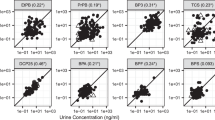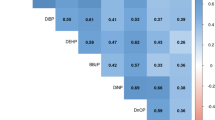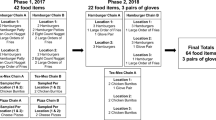Abstract
Information on associations between chlorpyrifos residues in food and personal exposure to chlorpyrifos would be valuable for evaluating the relationship between personal exposure and possible health effects. We used food consumption records, chlorpyrifos levels in duplicate plates, and measures of 3,5,6-trichloro-2-pyridinol (TCPy) in urine obtained from human volunteers in the National Human Exposure Assessment Survey in Maryland (NHEXAS-MD) to evaluate a food consumption–chemical residue model for estimating dietary intake of chlorpyrifos. Model inputs were the NHEXAS-MD food consumption records and chlorpyrifos residues in specific foods measured in the U.S. Food and Drug Administration Total Diet Study (TDS) market baskets from 1993 to 1997. The estimated mean and standard deviation of chlorpyrifos concentration (μg/kg) in duplicate plates (n=203) were within 20% and 50%, respectively, of the corresponding parameters of measured chlorpyrifos levels. However, predicted and measured concentrations in the 78 duplicate plates with detectable levels of chlorpyrifos were not significantly associated according to Spearman correlation analysis (r=0.04, p=0.7667) and linear regression (p=0.2726). Measured and estimated chlorpyrifos intakes for observations with non-zero values for each intake measure (n=71) were moderately associated on a rank (Spearman's r=0.24, p=0.0462) and linear basis (regression r2=0.07, p=0.0242). Measured intakes of chlorpyrifos from food and urinary TCPy were significantly correlated in rank order (n=87, Spearman's r=0.30, p=0.0041) and linear (n=87, Pearson's r=0.22, p=0.0409) analyses. Correlation coefficients between estimated intake of chlorpyrifos from food and TCPy were significantly different from zero (n=87; Spearman's r=0.22, p=0.0393; Pearson's r=0.21, p=0.0479). Comparing mean measured chlorpyrifos intake from food (0.46 μg/day) to mean estimated TCPy excretion via urine (6.3 μg/day), dietary intake of chlorpyrifos accounted for approximately 7% of TCPy in this population. These findings suggest the food consumption–chemical residue model can yield reasonably accurate estimates of the population distribution of dietary chlorpyrifos intake, but has little ability to predict dietary exposure for individuals; and that intake of chlorpyrifos from food is a minor contributor to TCPy in urine.
This is a preview of subscription content, access via your institution
Access options
Subscribe to this journal
Receive 6 print issues and online access
$259.00 per year
only $43.17 per issue
Buy this article
- Purchase on Springer Link
- Instant access to full article PDF
Prices may be subject to local taxes which are calculated during checkout
Similar content being viewed by others
References
Adgate JL Kukowski A Stroebel C Shubat PJ Morell S Quackenboss JJ Whitmore RW and Sexton K, Pesticide storage and use patterns in Minnesota households with children, J Expos Anal Environ Epidemiol (2000) 10(2): 159–167
Aitio A, and Kallio A, Exposure and effect monitoring: a critical appraisal of their practical application, Toxicol Lett (1999) 108(2–3): 137–147
Albers JW Cole P Greenberg RS Mandel JS Monson RR Ross JH Snodgrass WR Spurgeon A and van Gemert M, Analysis of chlorpyrifos exposure and human health: expert panel report, J Toxicol Environ Health, Part B: Crit Rev (1999) 2(4): 301–324
Bakke JE Feil VJ and Price CE, Rat urinary metabolites from O,O-diethyl-O-(3,5,6-trichloro-2-pyridyl) phosphorothioate, J Environ Sci Health, Part B (1976) 11(3): 225–230
Clegg DJ and van Gemert M, Determination of the reference dose for chlorpyrifos: proceedings of an expert panel, J Toxicol Environ Health, Part B: Crit Rev (1999) 2(3): 211–255
Costa LG Li WF Richter RJ Shih DM Lusis A and Furlong CE, The role of paraoxonase (PON1) in the detoxication of organophosphates and its human polymorphism, Chem Biol Interact (1999) 119–120: 429–438
EPA 2000a Organophospate pesticides: documents for chlorpyrifos. U.S. Environmental Protection Agency Office of Pesticide ProgramsAccessed June 30 http://www.epa.gov/pesticides/op/chlorpyrifos.htm
EPA 2000b Memorandum, HED Doc. No. 014077. U.S. Environmental Protection Agency FQPA Safety Factor Committee Accessed June 30 http://www.epa.gov/pesticides/op/chlorpyrifos/chlor_fqpa.pdf
FDA 1998 Food and drug administration pesticide program — residue monitoring — 1998. U.S. Food and Drug Administration Center for Food Safety and Applied Nutrition. Accessed March 6 http://vm.cfsan.fda.gov/-dms/pesrpts.html
Gibson JE Chen WL and Peterson RK, How to determine if an additional 10× safety factor is needed for chemicals: a case study with chlorpyrifos, Toxicol Sci (1999) 48(1): 117–122
Hill RH Jr. Head SL Baker S Gregg M Shealy DB Bailey SL Williams CC Sampson EJ and Needham LL, Pesticide residues in urine of adults living in the United States: reference range concentrations, Environ Res (1995) 71(2): 99–108
Hoppin J, Williams P, and Ryan P, A conceptual framework for the interpretation of biological markers for environmental exposure assessment, Hum Ecol Risk Assess (2000) 6(4): 711–725
Hunter DJ Rimm EB Sacks FM Stampfer MJ Colditz GA Litin LB and Willett WC, Comparison of measures of fatty acid intake by subcutaneous fat aspirate, food frequency questionnaire, and diet records in a free-living population of US men [see comments], Am J Epidemiol (1992) 135(4): 418–427
MacIntosh DL Spengler JD Ozkaynak H Tsai L and Ryan PB, Dietary exposures to selected metals and pesticides, Environ Health Perspect (1996) 104(2): 202–209
MacIntosh DL Williams PL Hunter DJ Sampson LA Morris SC Willett WC and Rimm EB, Evaluation of a food frequency questionnaire — food composition approach for estimating dietary intake of inorganic arsenic and methylmercury, Cancer Epidemiol Biomarkers Prev (1997) 6(12): 1043–1050
MacIntosh DL Hammerstrom K and Ryan PB, Longitudinal exposure to selected pesticides in drinking water, Hum Ecol Risk Assess (1999a) 5(3): 575–588
MacIntosh DL Needham LL Hammerstrom KA and Ryan PB, A longitudinal investigation of selected pesticide metabolites in urine, J Expos Anal Environ Epidemiol (1999b) 9(5): 494–501
MacIntosh DL Kabiru C Scanlon KA and Ryan PB, Longitudinal investigation of exposure to arsenic, cadmium, chromium and lead via beverage consumption, J Expos Anal Environ Epidemiol (2000) 10(2): 196–205
MacIntosh DL Kabiru C and Ryan PB, Longitudinal investigation of dietary exposure to selected pesticides, Environ Health Perspect (2001) 109(2): 145–150
McCurdy T, Conceptual basis for multi-route intake dose modeling using an energy expenditure approach, J Expos Anal Environ Epidemiol (2000) 10(1): 86–97
Nolan RJ Rick DL Freshour NL and Saunders JH, Chlorpyrifos: pharmacokinetics in human volunteers, Toxicol Appl Pharmacol (1984) 73(1): 8–15
Oliver GR Bolles HG and Shurdut BA, Chlorpyrifos: probabilistic assessment of exposure and risk, Neurotoxicology (2000) 21(1–2): 203–208
Olson CT Blank JA and Menton RG, Neuromuscular effects of low level exposures to Sarin, pyridostigmine, DEET, and chlorpyrifos, Drug Chem Toxicol (1998) 21(Suppl 1): 149–169
Racke K, Fontaine D, Yoder R, and Miller J, Environmental fate of chlorpyrifos, Reviews of Environmental Contamination and Toxicology. Springer-Verlag, G. Ware, New York. 1994 p. 131
Rice D, and Barone S Jr., Critical periods of vulnerability for the developing nervous system: evidence from humans and animal models, Environ Health Perspect (2000) 108(Suppl 3): 511–533
Rimm EB Giovannucci EL Stampfer MJ Colditz GA Litin LB and Willett WC, Reproducibility and validity of an expanded self-administered semi-quantitative food frequency questionnaire among male health professionals, Am J Epidemiol (1992) 135(10): 1114–1126, discussion 1127–1136
Romieu I Stampfer MJ Stryker WS Hernandez M Kaplan L Sober A Rosner B and Willett WC, Food predictors of plasma beta-carotene and alpha-tocopherol: validation of a food frequency questionnaire, Am J Epidemiol (1990) 131(5): 864–876
Roy TS Andrews JE Seidler FJ and Slotkin TA, Chlorpyrifos elicits mitotic abnormalities and apoptosis in neuroepithelium of cultured rat embryos [see comments], Teratology (1998) 58(2): 62–68
Russell-Briefel R Caggiula AW and Kuller LH, A comparison of three dietary methods for estimating vitamin A intake, Am J Epidemiol (1985) 122(4): 628–636
Ryan PB Huet N and MacIntosh DL, Longitudinal investigation of exposure to arsenic, cadmium, and lead in drinking water, Environ Health Perspect (2000) 108(8): 731–735
Ryan P, Scanlon K, and MacIntosh D, Analysis of dietary intake of selected metals in the NHEXAS-Maryland investigation, Environ Health Perspect (2001) 109(2): 121–128
Sams C, and Mason HJ, Detoxification of organophosphates by A-esterases in human serum, Hum. Exp. Toxicol. (1999) 18(11): 653–658
Scanlon KA MacIntosh DL Hammerstrom KA and Ryan PB, A longitudinal investigation of solid-food-based dietary exposure to selected elements, J Expos Anal Environ Epidemiol (1999) 9(5): 485–493
Schofield WN, Predicting basal metabolic rate, new standards and review of previous work, Hum Nutr: Clin Nutr (1985) 39C(Suppl 1): 5–41
Slotkin TA, Developmental cholinotoxicants: nicotine and chlorpyrifos, Environ Health Perspect (1999) 107(Suppl 1): 71–80
Steenland K Dick RB Howell RJ Chrislip DW Hines CJ Reid TM Lehman E Laber P Krieg EF Jr. and Knott C, Neurologic function among termiticide applicators exposed to chlorpyrifos, Environ Health Perspect (2000) 108(4): 293–300
Thomas KW Sheldon LS Pellizzari ED Handy RW Roberds JM and Berry MR, Testing duplicate diet sample collection methods for measuring personal dietary exposures to chemical contaminants, J Expos Anal Environ Epidemiol (1997) 7(1): 17–36
USDA 1998 1994–1996 Continuing Survey of Food Intakes by Individuals and Diet and Health Knowledge Survey on CD-ROM. U.S. Department of Agriculture, Riverdale, MD
Vander A, Sherman J, and Luciano D, Human Physiology, The Mechanisms of Body Function. McGraw-Hill, New York, 1990
Whitemore RW Immerman FW Camann DE Bond AE Lewis RG and Schaum JL, Non-occupational exposures to pesticides for residents of two U.S. cities, Arch Environ Contam Toxicol (1994) 26(1): 47–59
Willett WC Sampson L Stampfer MJ Rosner B Bain C Witschi J Hennekens CH and Speizer FE, Reproducibility and validity of a semiquantitative food frequency questionnaire, Am J Epidemiol (1985) 122(1): 51–65
Wolt JD, Exposure endpoint selection in acute dietary risk assessment, Regul Toxicol Pharmacol (1999) 29(3): 279–286
Zartarian VG Ozkaynak H Burke JM Zufall MJ Rigas ML and Furtaw EJ Jr., A modeling framework for estimating children's residential exposure and dose to chlorpyrifos via dermal residue contact and non-dietary ingestion, Environ Health Perspect (2000) 108(6): 505–514
Zheng Q Olivier K Won YK and Pope CN, Comparative cholinergic neurotoxicity of oral chlorpyrifos exposures in preweanling and adult rats, Toxicol Sci (2000) 55(1): 124–132
Acknowledgements
We thank Kelly Scanlon, formerly of Emory University, and Lisa Melnyk, Maurice Berry, and Karen Hammerstrom of the U.S. Environmental Protection Agency, for their contributions to this project. This research was supported by the U.S. Environmental Protection Agency under cooperative agreement no. CR822038-1, the U.S. Department of Agriculture Hatch project no. GEO00843, and the University of Georgia Research Foundation.
Author information
Authors and Affiliations
Corresponding author
Rights and permissions
About this article
Cite this article
MACINTOSH, D., KABIRU, C., ECHOLS, S. et al. Dietary exposure to chlorpyrifos and levels of 3,5,6-trichloro-2-pyridinol in urine. J Expo Sci Environ Epidemiol 11, 279–285 (2001). https://doi.org/10.1038/sj.jea.7500167
Received:
Published:
Issue Date:
DOI: https://doi.org/10.1038/sj.jea.7500167
Keywords
This article is cited by
-
Nitrogen contaminants damage on intestinal epithelial tight junctions: a review
Environmental Chemistry Letters (2021)
-
Organophosphorus pesticide chlorpyrifos intake promotes obesity and insulin resistance through impacting gut and gut microbiota
Microbiome (2019)
-
Human exposures to PAHs: an eastern United States pilot study
Environmental Monitoring and Assessment (2013)
-
Dietary patterns among the Metro Atlanta Cohort: Implications for population-based longitudinal dietary pesticide exposure and risk assessment
Journal of Exposure Science & Environmental Epidemiology (2011)
-
Reconstructing population exposures to environmental chemicals from biomarkers: Challenges and opportunities
Journal of Exposure Science & Environmental Epidemiology (2009)



